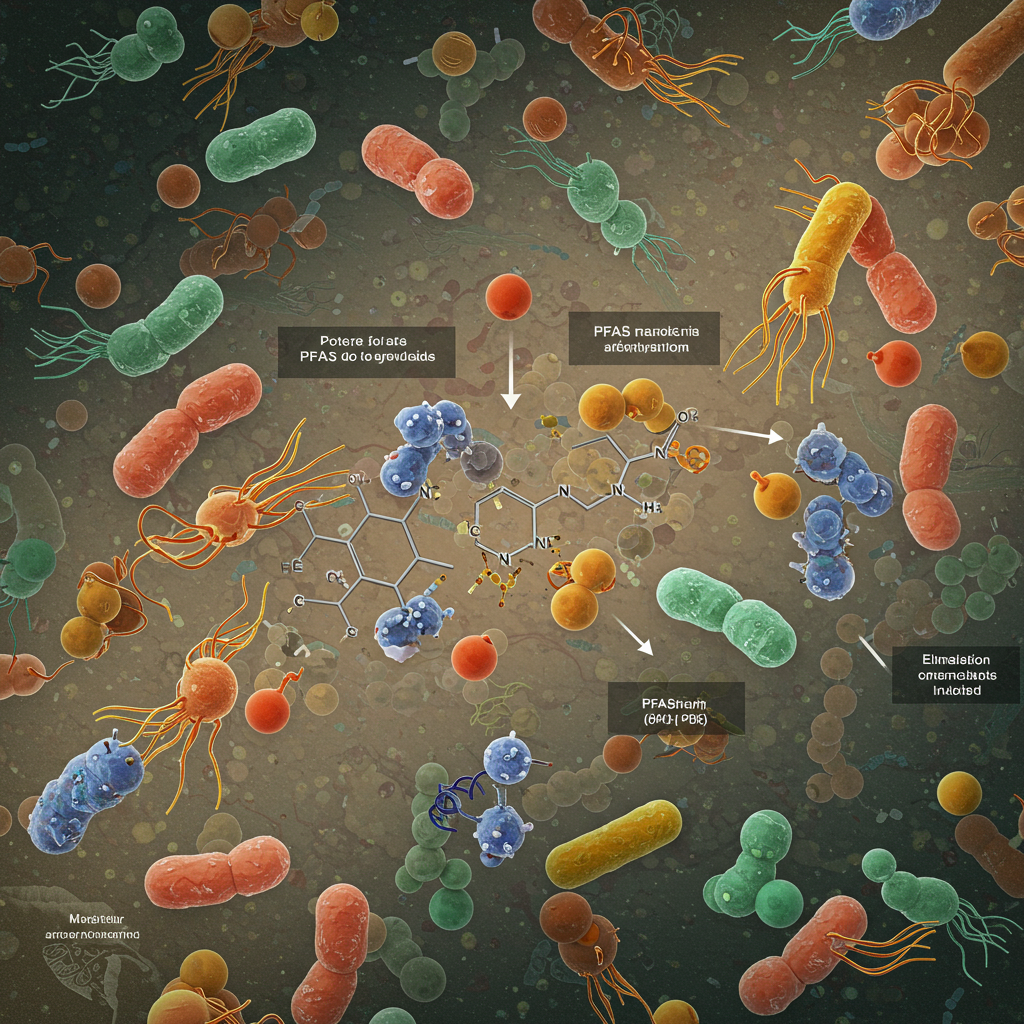Per- and polyfluoroalkyl substances (PFAS) are synthetic chemicals found everywhere, from non-stick pans and waterproof clothes to our drinking water and even our bodies. Dubbed “forever chemicals” because they resist breakdown, PFAS can persist in the environment and human tissues for centuries. Mounting research links chronic PFAS exposure to serious health issues, including certain cancers, reproductive problems, thyroid disease, and weakened immune function. While scientists race to remove PFAS from the environment, a promising new study offers a potential way to tackle these persistent pollutants after they enter the body: using common human gut bacteria.
Published in Nature Microbiology, research from the University of Cambridge suggests that certain strains of bacteria living in our digestive system possess a remarkable ability to capture and accumulate PFAS. This discovery presents a “glimmer of hope” in the ongoing battle against the pervasive PFAS problem, according to study co-author Kiran Patil, a molecular biologist at the University. He posits that our long-standing microbial companions might already be helping us cope with these modern toxins.
The Pervasive Problem of “Forever Chemicals”
PFAS are a large group of over 4,700 different man-made chemicals. They are valued in industry for their resistance to water, grease, and stains, leading to widespread use in countless consumer and industrial products. Beyond cookware and apparel, PFAS turn up in food packaging, firefighting foam, and even some personal care items.
Once released, these chemicals are incredibly difficult to eliminate from the environment, contaminating soil, air, and especially water sources. Studies show that PFAS are detectable in the tap water of nearly half of Americans. Their stability also means they readily accumulate in the human body over time, where they can linger for years. This persistence and bioaccumulation are what make them such a significant health concern. Potential health impacts range from increased risks of certain cancers (kidney, testicular) and reproductive issues to elevated cholesterol, liver damage, and developmental delays, particularly in children.
Traditional methods for addressing PFAS contamination often focus on environmental cleanup or filtering water before consumption. While crucial, these don’t address the chemicals already inside the body. This is where the Cambridge study offers a novel perspective.
A Glimmer of Hope: Gut Bacteria to the Rescue?
The Cambridge research team set out to investigate how pollutants, including PFAS, interact with the complex ecosystem of the human gut microbiome. Testing numerous bacterial strains commonly found in the human gut, they made a significant observation: nine specific strains demonstrated a surprising capacity to accumulate certain PFAS chemicals.
Identifying PFAS-Absorbing Strains
In controlled laboratory settings, these selected bacterial strains were able to “sop up” between 25% and 74% of the PFAS chemicals they were exposed to within a 24-hour period. This absorption efficiency was notable, even at varying chemical concentrations. Researchers initially suspected the PFAS molecules might simply cling to the bacteria’s outer surfaces. However, the quantity being absorbed was too high for simple surface binding.
To investigate further, the team employed advanced imaging techniques. By rapidly freezing the bacteria and analyzing them with charged particle beams, they detected fluorine molecules concentrated inside the bacterial cells. Since fluorine is a key element in PFAS structure, this confirmed that the bacteria were actively taking the chemicals into their interior, storing them in dense clumps, rather than just adhering to the surface. This internal accumulation appears to offer the bacteria some protection from the chemicals’ potential toxicity.
Proving the Concept in Living Systems
Moving beyond lab dishes, the scientists tested whether this PFAS accumulation would still occur within a living organism. They used mice specifically bred to lack their own gut microbiome and then introduced several of the identified human bacterial strains that showed high PFAS absorption in the lab.
After exposing these mice to various levels of a PFAS chemical, the researchers measured the amount excreted in the animals’ feces. The results were compelling: mice colonized with the PFAS-collecting bacteria excreted significantly more of the toxic chemicals than mice without these specific microorganisms. This demonstrated that these bacteria could bind to and potentially help remove PFAS from the body via waste elimination.
Environmental epidemiologist Jesse Goodrich, who was not involved in the study, noted that this research “shows just how deeply PFAS penetrate a body and its systems” and adds another piece to the complex puzzle of how PFAS impact human health.
What This Means and What Comes Next
The findings suggest that specific human gut bacteria possess an inherent ability to bind and sequester PFAS chemicals. If this mechanism proves effective in humans, it could open new avenues for reducing the body’s burden of these persistent pollutants.
The research team is not stopping with the mice study. Their next crucial step is planning a clinical trial in humans. This trial aims to test whether administering probiotics containing these specific PFAS-absorbing bacterial strains can supplement the natural human microbiome and help decrease PFAS levels in the gut.
However, transitioning from highly controlled mouse studies to human trials presents significant challenges. As study lead author Anna Lindell, a toxicologist at Cambridge, points out, the human microbiome exhibits “huge variation” in its composition from person to person. This variability makes predicting how introduced probiotic strains will behave and interact within different individuals far more complex than in lab-designed mouse microbiomes. Future research may also involve observing individuals with naturally high levels of these specific bacterial strains to see if they correlate with lower PFAS levels in their bodies.
While the idea of using bacteria to manage internal PFAS absorption is “interesting and has potential,” as Goodrich puts it, he rightly emphasizes a critical point: “ultimately, the best way to protect health is to prevent exposure in the first place.”
Beyond Bacteria: Current Strategies for Reducing PFAS Exposure
Given that bacterial “therapy” for PFAS is still in the research phase, the most effective strategy right now is to minimize your exposure to these chemicals in your daily life.
Here are some actionable steps:
Filter Your Water: PFAS are commonly found in tap water. Certain types of home water filters are highly effective at removing them. Look for filters certified by independent organizations like NSF/ANSI standards 53 or 58 for PFAS reduction. Effective technologies include activated carbon filters, ion exchange, and particularly reverse osmosis systems. Be sure to maintain and replace filters according to manufacturer instructions to avoid potential bacterial buildup.
Avoid Certain Products: Choose stainless steel, cast iron, or ceramic cookware instead of non-stick pans treated with PFAS. Opt for clothing and upholstery that are not marketed as stain-resistant or waterproof with chemical treatments. Be mindful of food packaging, as some can contain PFAS coatings.
Support Legislation: Advocate for or support policies that restrict or ban the use of intentionally added PFAS in consumer products and manufacturing processes. Many states and the federal government are working on such regulations, but consumer awareness and demand can drive change.
Consider Dietary Changes: While not a direct PFAS removal method like the study bacteria, some preliminary research (separate from the Cambridge study) suggests certain dietary fibers, like beta-glucan found in oats, might help bind to toxins in the digestive tract and aid in their elimination. Supporting overall gut health with a fiber-rich diet and diverse beneficial bacteria is generally good for processing waste and toxins. Foods rich in various probiotics, like fermented foods (yogurt, kefir, sauerkraut, kimchi), contribute to a healthy microbiome, though they don’t specifically contain the PFAS-absorbing strains identified in the study.
This new research into gut bacteria’s potential is exciting, but it is one piece of a larger strategy needed to address the pervasive issue of PFAS contamination. Combining environmental efforts, prevention, and future potential therapeutic approaches will be key to reducing the health burden of these persistent chemicals.
Frequently Asked Questions
What type of gut bacteria helps remove PFAS, according to the study?
The recent study identified nine specific strains of bacteria commonly found in the human gut microbiome that demonstrated the ability to accumulate per- and polyfluoroalkyl substances (PFAS). These specific strains showed high efficiency in absorbing PFAS chemicals, not just binding them to their surface but drawing them inside the bacterial cells where they form dense clumps.
Can I use probiotics or diet changes now to remove PFAS from my body?
Based on the current research, specific probiotic supplements designed to remove PFAS do not yet exist. The study is promising, but human clinical trials are still in the planning stages to test this concept. While a healthy diet, rich in fiber and diverse fermented foods containing various probiotics, is beneficial for overall gut health and toxin processing, it is not currently proven to remove PFAS specifically using the mechanism found in the study. The most effective actions now are preventing exposure through water filtration and avoiding products containing PFAS.
How do these specific bacteria collect ‘forever chemicals’ like PFAS?
The identified gut bacteria strains don’t just stick to PFAS; they actively absorb the chemicals into their interior. Using advanced imaging, researchers confirmed that PFAS molecules, indicated by their fluorine content, were concentrated inside the bacterial cells. The bacteria appear to sequester these chemicals in dense clumps within their structure, effectively gathering them up. The theory is that these bacteria could then carry the captured PFAS out of the body during waste elimination.
Conclusion
The discovery that specific human gut bacteria can absorb PFAS chemicals represents a significant and hopeful step in the fight against these persistent pollutants. While the research is still in its early stages, particularly regarding human application, it highlights the potential of harnessing our own microbiome to address environmental toxins that have infiltrated our bodies. The planned human trials are a crucial next step toward developing potential probiotic therapies. However, for now, the most effective strategies remain focused on prevention: filtering drinking water and making conscious choices to avoid products known to contain PFAS. By combining proactive prevention with ongoing scientific innovation, we can work towards reducing the health risks associated with these widespread “forever chemicals.”




